Old World warblers are a large group of birds formerly grouped together in the bird family Sylviidae. The family held over 400 species in over 70 genera, and were the source of much taxonomic confusion. Two families were split out initially, the cisticolas into Cisticolidae and the kinglets into Regulidae. In the past ten years they have been the subject of much research and many species are now placed into other families, including the Acrocephalidae, Cettiidae, Phylloscopidae, and Megaluridae. In addition some species have been moved into existing families or have not yet had their placement fully resolved. A smaller family of warblers, together with some babblers formerly placed in the family Timaliidae and the parrotbills, are retained in a much smaller family Sylviidae.

The red-throated lorikeet is a critically endangered lorikeet endemic to Fiji. It is 18 cm long and is bright green overall, with red cheeks, throat and thighs.

The Fiji parrotfinch is a species of estrildid finch endemic to Fiji that was formerly considered to be a subspecies of the red-headed parrotfinch. This parrotfinch is a small, mainly green bird with a red head and tail and a stubby dark grey bill. It is found in both forested and open habitats, and has adapted well to man-made environments such as grasslands, pasture and gardens. Pairs have a courtship display in which they fly above the trees in an undulating flight, calling constantly. Breeding birds build a domed grass nest with a side entrance, and lay a clutch normally of four white eggs. Newly hatched chicks are naked and pink, with blue balls at the upper and lower corners of the gape, and black markings inside the mouth; older fledglings resemble the adults, but lack the red head colouring. The Fiji parrotfinch eats seeds, especially of grasses, and also readily feeds on insects and nectar. It forms small flocks of up to six birds after the breeding season.

The pink-billed parrotfinch is a species of estrildid finch found on the island of Viti Levu, Fiji. Commonly found at undisturbed mature forest in the centre and east of Viti Levu, e.g. Joske's Thumb near Suva. This species is found at mid-height along tree-trunks and branches, usually alone or in pairs but also joining mixed-species flocks, feeding primarily on insects, but also on flower buds and fruits.
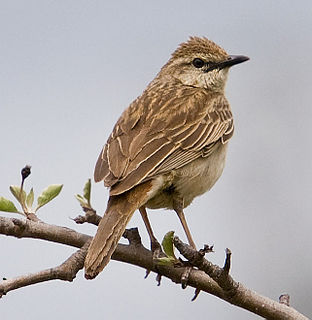
Cincloramphus is a genus of birds in the grassbird family Locustellidae.
The Bougainville thicketbird is a bird species. It had been placed in the "Old World warbler" family Sylviidae, but it does not seem to be a close relative of the typical warblers; probably it belongs in the grass warbler family Locustellidae. It is endemic to Bougainville Island. Its natural habitat is subtropical or tropical dry lowland grassland. It used to be considered conspecific with the Santo thicketbird and the New Britain thicketbird.

The New Caledonia thicketbird or New Caledonia grassbird, is a bird species. Previously placed in the "Old World warbler" family Sylviidae, it does not seem to be a close relative of the typical warblers; probably it belongs in the grass warbler family Locustellidae. This species is endemic to New Caledonia.
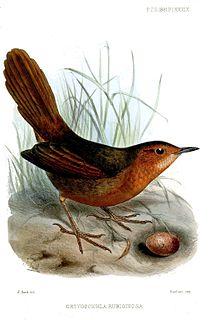
The rusty thicketbird is a bird species. Previously placed in the "Old World warbler" family Sylviidae, it does not seem to be a close relative of the typical warblers; probably it belongs in the grass warbler family Locustellidae. It is found in New Britain only.

Mount Tomanivi, previously named Mount Victoria and also known as Tomaniivi, is an extinct volcano located in the northern highlands of Viti Levu. At 1,324 metres (4,344 ft), Mount Tomanivi is the highest mountain in Fiji. A trail leads to the summit of Tomanivi from the village of Navai. The main river systems, the Rewa, Navua, Sigatoka, and Ba, all have their headwaters in the central mountain area.
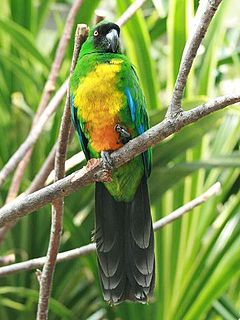
The masked shining parrot, also known as the masked parrot, masked musk parrot, or the yellow-breasted musk parrot is a species of parrot in the family Psittaculidae. It is endemic to Viti Levu in Fiji. Its natural habitats are subtropical or tropical moist lowland forest, subtropical or tropical mangrove forest, subtropical or tropical moist montane forest, arable land, and rural gardens. It is threatened by habitat loss.
The long-billed forest warbler, also known as the long-billed tailorbird, is a songbird of the family Cisticolidae, formerly part of the "Old World warbler" assemblage. It is found in Tanzania and Mozambique. Its natural habitat is subtropical or tropical moist montane forests. It is threatened by habitat destruction.

The Fiji woodswallow is a species of woodswallow in the family Artamidae. It is endemic to most of the islands of Fiji, although it is absent from Kadavu Archipelago and the Lau Archipelago. The species was once considered a race of the white-breasted woodswallow, which breeds from Australia, New Caledonia and Vanuatu through to Borneo and the Philippines. Some authors retain it in that species.

The Polynesian triller is a passerine bird belonging to the triller genus Lalage in the cuckoo-shrike family Campephagidae. It has numerous subspecies distributed across the islands of the south-west Pacific.
The Cordillera ground warbler, also known as Rabor's wren-babbler or the Luzon wren-babbler, is a species of bird currently placed in the family Locustellidae. It is endemic to the Philippines, where it is found in northwest Luzon in the foothills of the Cordillera Mountain Range. Some taxonomists continue to list the species in the Timaliidae, others in the Pellorneidae. Its natural habitat is tropical moist lowland forests. It is threatened by habitat loss.

The Fiji white-eye is a species of passerine bird in the white-eye family Zosteropidae. The species is also known as Layard's white-eye.
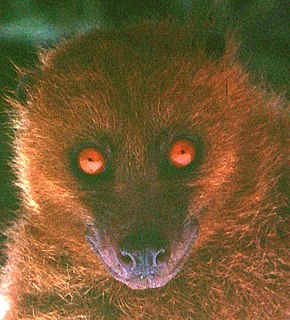
The Fijian monkey-faced bat Also known as Fijian flying fox or Fijian flying monkey, is a megabat endemic to Fiji. It was discovered in old-growth cloud forest on Des Vœux Peak, the second highest mountain peak on the island of Taveuni by William and Ruth Beckon in 1976, and is Fiji's only endemic mammal. It has recently been transferred from Pteralopex to its own monotypic genus Mirimiri.
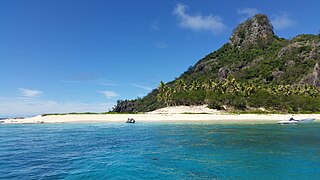
Monuriki is a small, uninhabited island situated off the coast of Viti Levu in the Fiji Islands, in Melanesia in the South Pacific Ocean. Monuriki is part of the Atolls islands, and related to a group of three islets in the larger group of islands known as the Mamanuca Islands. This coral and volcanic island is the smallest islet and the southernmost of a small group of three islets, west of Tavua.
The Sovi Basin is located in Naitasiri Province, on the island of Viti Levu, the largest island in Fiji. Covering approximately 19,600 hectares, the basin is blanketed by a well-preserved tropical lowland forest, which is Fiji's largest and most biologically diverse. Sovi basin resides within the Polynesia/Micronesia biodiversity hotspot, one of 34 hot spots throughout the globe. The site is to be protected in a partnership between Fiji Water and Conservation International. The rainforest, wilderness area and high scenic valley contribute to its national significance as outlined in Fiji's Biodiversity Strategy and Action Plan.
The Natewa silktail is a species of bird endemic to Fiji. This beautiful bird looks superficially like a diminutive bird-of-paradise but it is actually closely related to the fantails.

The Fiji tropical moist forests is a tropical moist forest ecoregion in Fiji and Wallis and Futuna. It covers the windward sides of Viti Levu and Vanua Levu, Fiji's largest islands, as well as the smaller Fijian islands and the three islands that make up Wallis and Futuna, an overseas territory of France.














